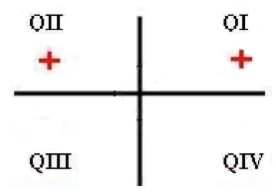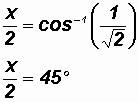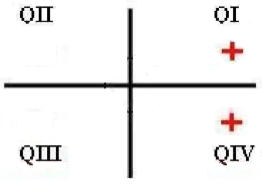SOLVING COMPLEX TRIGONOMETRIC EQUATIONS
Example 1:
Solve 2sin2 x
3sin x + 1 = 0 for x on the interval
. Express the solutions in degrees.
Step 1:
This equation is "quadratic" in form. That is, one variable (sin x) is raised to the second power and the other, same variable, is raised to the first power.
Nothing needs to be done because the equation only contains sine ratios.
Step 2:
We are going to use the Quadratic Formula to find one or more simple trigonometric equations. To make the solution process a little bit more palatable, let's use the following substitution. That is, we let sin x = k, then sin2 x = k2.
It follows that 2sin2 x
3sin x + 1 = 0 becomes 2k2
3k + 1 = 0.
We are now going to use the Quadratic Formula
, but our variable will be k instead of x.
For this procecure, we notice that a = 2, b =
3 and c = 1.
Then
and
.
We find two solutions, namely
and
.
Since k is actually equal to sin x, we will back-substitute to get sin x = 1 and sin x =
We now have two simple trigonometric equations. We must try to find solutions for both.
Steps 3 through 6:
Let's find the solutions of the two simple trigonometric equations we would in Step 2.
We will use the calculator to solve sin x =
.
Using the arcsine, we find x = 30o, which indicates a reference angle of 30o.
Next, we will use All Students Take Calculus to find the quadrants in which the sine ratio is positive.
We need to find angles located in QI and QII that have a reference angle of 30o. We find the solutions for angle x on the interval
to be as follows:
Solution in QI:
x1 = 30o
Solution in QII:
x2 = 180o
30o = 150o
We will use the calculator to solve sin x = 1.
With the calculator in degrees and using the arcsine, we find x = 90o, which indicates a Quadrantal Angle, therefore, there is no reference angle.
Next, we use the following picture:
We find one solution for angle x on the interval
to be 90o.
In summary, the solutions of 2sin2 x
3sin x + 1 = 0 on the interval
are 30o, 90o, and 150o.
Example 2:
Solve sin2x
2cos x
2 = 0 for x on the interval
. Express the solutions in degrees.
Step 1:
This equation is "quadratic" in form. However, it contains sine and cosine ratios. We must change the equation so that it contains either all cosines or all sines.
Remembering the Pythagorean Identity sin2x = 1
cos2 x, we can change the given equation to the following:
(1
cos2 x)
2cos x
2 = 0
Writing in descending powers of cos x:
cos2 x
2cos x
1 = 0
Finally, we will multiply both sides by
1 to get cos2 x + 2cos x + 1 = 0.
Step 2:
We are going to use the Quadratic Formula to find one or more simple trigonometric equations. To make the solution process a little bit more palatable, let's use the following substitution. That is, we let cos x = k, then cos2 x = k2.
It follows that cos2 x + 2cos x + 1 = 0 becomes k2 + 2k + 1 = 0.
We are now going to use the Quadratic Formula
, but our variable will be k instead of x.
For this procecure, we notice that a = 1, b = 2 and c = 1.
Then
and
.
We find one solution, namely k =
1.
Since k is actually equal to cos x, we will back-substitute to get cos x =
1. and find its solutions.
Steps 3 through 6:
Let's find the solutions of the two simple trigonometric equations we would in Step 2.
We will use the calculator to solve cos x =
1.
With the calculator in degrees and using the arccosine, we find x = 180o, which indicates a Quadrantal Angle, therefore, there is no reference angle.
Next, we use the following picture:
In summary, there is only one solution of sin2x
2cos x
2 = 0 on the interval
, namely x = 180o.
Example 3:
Solve 4 sin2 x cot x
cot x = 0 for x on the interval
. Express the solutions in radians.
Step 1:
This equation contains sine and cotangent ratios with one of the cotangent ratios being connected to the squared sine ratio via multiplication. Therefore, we will NOT attempt to change the equation so that it contains either all sines or all cotangents.
Step 2:
Trying to find one or more simple trigonometric equations using theQuadratic Formula would be nearly impossible. Luckily, we notice that cot x is the greatest common factor between the two terms. Therefore, we will start by factoring it out.
4 sin2 x cot x
cot x = 0
cot x (4 sin2 x
1) = 0
Now we will use the Zero Product Principle which allows us to set both factors equal to 0. We will get two equations.
(1) cot x = 0
This is a simple trigonommetric equation. We will solve it in Steps 3 through 6 below.
(2) 4 sin2 x
1 = 0
This is still a quadratic equation. We could use the Quadratic Formula to solve it. However, we know from algebra that we can use a short-cut method called the Square Root Property when the equation only contains a squared variable.
First, we will isolate the squared term on one side of the equal sign to get
. Note that the coefficient of the squared term must be 1!
Then we will take the square root of oth sides to get
. Here, we actually have two equations, namely sin x =
and sin x =
.
We now have three simple trigonometric equations. We must try to find solutions for all of them.
Steps 3 through 6:
Let's find the solutions of the three simple trigonometric equations we would in Step 2.
Finding the angle x for cot x = 0 with the calculator is cumbersome.
Hopefully, we remember that the cotangent ratio is only 0 when the angle is quadrantal. We also hopefully remember that
.
The sine ratio cannot equal 0 otherwise the cotangent ratio is undefined. Let's look at the following picture.
At which angles is the sine ratio NOT equal to 0? We find two solution for angle x on the interval
, namely
/2 and 3
/2.
We will use the calculator to solve sin x =
and sin x =
.
With the calculator in degrees and using the arcsine, we find x = 30o and x =
30o, which indicates a reference angle of 30o in both cases.
Next, we will use All Students Take Calculus to find the quadrants in which the sine ratio is positive. Therefore, the sine in negative in QIII and QIV.

We need to find angles located in QI, QII, QIII, and QIV that have a reference angle of 30o. We find the solutions for angle x on the interval
to be as follows:
Solution in QI:
x1 = 30o
/6
Solution in QII:
x2 = 180o
30o = 150o
5
/6
Solution in QIII:
x2 = 180o + 30o = 210o
7
/6
Solution in QIV:
x2 = 360o
30o = 330o
11
/6
In summary, the solutions of cot x = 4 sin2 x cot x on the interval
are
/2, 3
/2,
/6 , 5
/6, 7
/6, and 11
/6.
Example 4:
Solve
for x on the interval
. Express the solutions in degrees.
Step 1:
This equation is "quadratic" in form. However, it only contains a squared cosine ratio.
Step 2:
We will try to find simple trigonometric equations by using the Square Root Property instead of the Quadratic Formula.
First, we must change the leading coefficient of the square trigonometric term to 1 by dividing both sides of the equation by 2.
We can now apply the Square Root Property to
. Subsequently we get
We now have two simple trigonometric equations, namely
and
We must try to find solutions for both.
Steps 3 through 6:
Let's find the solutions of the two simple trigonometric equations we would in Step 2.
We will use the calculator to solve
and
.
With the calculator in degrees and using the arccosine, we find x = 45o and x = 135o, which indicates a reference angle of 45o in both cases.
Next, we will use All Students Take Calculus to find the quadrants in which the cosine ratio is positive. Therefore, the cosine is negative in QII and QIII.
and
We need to find angles located in QI, QII, QIII, and QIV that have a reference angle of 45o. We find the solutions for the angle x on the interval
to be as follows:
Solution in QI:
x1 = 45o
Solution in QII:
x2 = 180o
45o = 135o
Solution in QIII:
x3 = 180o + 45o = 225o
Solution in QIV:
x4 = 360o
45o = 315o
In summary, the solutions of
on the interval
are 45o, 135o, 225o, and 315o.
Example 5:
Solve
for x on the interval
. Express the solutions in degrees.
Here we we have an equation were bx =
which is the same as
x.
Please note that we will work with the angle
through Step 5. Only in Step 6 will we find the solution(s) for angle x.
Step 1:
The solution interval for angle x is
.
The solution interval for angle
is half of this, namely
.
Steps 2 through 5:
Isolate the trigonometric expression on one side:
We are going to use the concept of Inverse Trigonometric Functions to solve for the angle
using the calculator in degree mode.
Please note that you cannot at this point multiply both sides of the equation by 2 to get a solution for angle x!!!
The reference angle for angle
equals 45o.
The value of the cosine ratio in (2) is positive and we have a reference angle.
We will use All Students Take Calculus to find the quadrants in which the cosine ratio is positive. It is best to draw a picture!
Finally, we are going to use the reference angle from Step 3. We need to find angles located in QI and QIV that have a reference angle of 45o.
Therefore, the solutions for angle
on the interval
are as follows:
= 45o
and
= 360o
45o = 315o
Step 6:
Since we are asked to solve for angle x, we must now multiply both sides of the above equations by 2 to get
In summary, the solutions of
on the interval
are 90o and 630o.
Example 6:
Solve
for x on the interval
. Express the solutions in EXACT radians.
Here we we have an equation were bx = 4x.
Please note that we will work with the angle 4x through Step 5. Only in Step 6 will we find the solution(s) for angle x.
Step 1:
The solution interval for angle x is
.
The solution interval for angle 4x is four times as large as this, namely
.
Steps 2 through 5:
Isolate the trigonometric expression on one side:
We are going to use the concept of Inverse Trigonometric Functions to solve for the angle 4x using the calculator.
Let's work with degrees! Using the calculator in degree mode, we find
Please note that you cannot at this point divide both sides of the equation by 4 !!!
The reference angle of angle 4x equals 30o.
The value of the sine ratio in (2) is positive and we have a reference angle.
Qe will use All Students Take Calculus to find the quadrants in which the sine ratio is positive. It is best to draw a picture!
Finally, we are going to use the reference angle from Step 3. Now, remember the solution interval for angle 4x is
in degrees.
However, we are going to find angles in the solution interval
first. They must be in QI and QII and have a reference angle of 30o.
They are
4x1 = 30o
4x2 = 180o
30o = 150o
Since we are supposed to find solutions for angle 4x on the interval
, we must add the following angles, which are coterminal to the two we already found:
4x3 = 30o + 360o = 390o
4x4 = 150o + 360o = 510o
Let's go ahead and express these four solutions in radians as follows:

Step 6:
Since we are asked to solve for the angle x, we must now divide both sides of the above equations by 4 to get



In summary, the solutions of
on the interval
are



.





